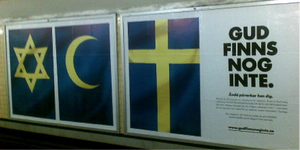Do National Histories Matter? Explaining the Diversity of Atheism
In Wednesday’s post by Stephen LeDrew, the focus was on diversity within American atheism. Today we make the jump from American atheism to European atheism. Teemu Taira will explore the differences between atheism in Finland and atheism in Sweden and relate them to the national histories of these Scandinavian countries and the role that the media has played in making people aware of atheism.
In his book Society Without God (2008) American sociologist Phil Zuckerman compares and contrasts Scandinavia and the United States of America.[1] He demonstrates that Scandinavians, or to be precise, Danes and Swedes, are one of the most irreligious people in the whole world, and particularly so when compared with the USA.
While Zuckerman’s study is relevant in itself, his approach has at least three problems: first, it tends to unify and homogenize Nordic countries. Second, while focusing on the irreligiosity of the area, it neglects the prominent public roles that the dominant Lutheran churches have in each Nordic country despite the relatively weak pressure to believe in any of the doctrines of these national churches. Third, the approach bypasses significant differences in the popularity of atheism between Nordic countries. It is this third aspect that I want to address in more detail, because it has implications for explaining the diversity of atheism.
For instance, the neighbouring countries applying the Nordic welfare model, Finland and Sweden, differ surprisingly much when it comes to atheism. Let’s look at the statistics first. Less than 65 percent of the Swedes are members of the Church of Sweden, whereas in Finland 74 percent of the population was member of the Evangelical Lutheran Church of Finland in 2014.The numbers are in decline as in 2008 the membership rates were 73 and 81 percent respectively. Furthermore, 18 percent of the Swedes explicitly believe in God, while 33 percent of the Finns believe in God according to Eurobarometer 2010. The percentages of those who explicitly don’t believe were 34 and 22 respectively.

On the basis of these surveys it can be argued that Sweden is a slightly more secular country than Finland. The pattern is even clearer when atheism is studied. One of the striking examples was in the results of the World Values Survey in 2005. According to the survey, 17 percent of the Swedes identify as atheists, whereas in Finland the percentage of atheists was only three. Although the percentage has varied from one survey to another, this is a comparable example where the same question with the same options were used. This demonstrates that the level of atheism in Sweden is closer to other relatively irreligious European countries, whereas the level of atheism in Finland is comparable to selected Catholic countries (Mexico, Chile, Italy) and Orthodox Cyprus.
The question is, then, how to explain the difference between Sweden and Finland?
With regard to the debate concerning secularization, British sociologist of religion David Martin wrote that the relevance of secularization “is profoundly inflected by particular histories, which in the modern period are national histories qualified in a minor or major way by regional variations”.[2] By taking this as the leading idea, the difference between Sweden and Finland can be illuminated.
Finland was part of Russia from 1809 to its independence in 1917.From 1917 until the early 1990s it was one of the neighbours of the Soviet Union, an officially atheist state. The Evangelical Lutheran Church of Finland played a major role in times of crisis in the twentieth century, such as during the Civil War in 1918 and during the Second World War. Both were crucial for building a Christian identity for a young independent country. In the Civil War, the ‘Reds’ who lost were labelled Communists and in the Second World War, Finland was fighting against the Soviet Union. To cut a long story short, the Lutheran church has become part of what is deemed as Finnish identity.[3] This historical development explains why being a member of the church or at least having a rather positive attitude towards the Lutheran church has become what is considered to be a normal part of what it is to be a Finn. For the same reason, atheism – and explicit criticism of the dominant church – has been associated with anti-Finnishness in Finland, especially because atheism has been associated with the Communist Soviet Union.[4]
Despite the similarities in social structures between Sweden and Finland, the history of Sweden is very different when it comes to atheism. It has not had the significant atheist other as Finland has.
This lesson should be kept in mind when global surveys of religiosity and/or atheism are interpreted. Although I am not an expert in atheism in Asia or South America, the examination of survey results show how problematic the results can be without understanding national histories.
For instance, according to the Global Index of Religiosity and Atheism survey (2012), 30 percent of Vietnamese people are religious, 65 percent are non-religious and the rest do not know. What is striking is that there are no atheists, even though that was one of the four options that could be chosen, besides religious, non-religious and do not know. This example suggests that the discourse in Vietnam is very different from European countries.
Uruguay provides another example. According to the International Social Survey Programme (2008), 33 percent of respondents are nonreligious in Uruguay. This percentage is surprisingly high – higher than in many European countries. However, according to the same survey, 71 percent of people in Uruguay believe in God, only 12 percent do not believe in God and 66 percent believe in religious miracles. So it looks like many people regard themselves as nonreligious, but it does not mean the same as in most European countries as it does not correlate with a low percentage of belief in God.
There is a lot of diversity in atheism. Therefore, more comparative research is needed, but this research has to be sensitive to national histories and to the meanings and associations of the terms used. Otherwise the diversity of atheism from one region to another is not explained satisfactorily. This was one of the ideas of round table seminar I co-organised in Finland in early 2012 and it led to the special issue in an online journal Approaching Religion. Other good examples that pay attention to the diversity of atheism on a national level are a forthcoming edited volume on the atheist bus campaign in different countries,[5] and the recent edited volume Atheist Identities: Spaces and Contexts, although the scope of the latter is limited to the US, Canada and UK.[6]
It is not only differences at the national level that matter. There are also differences in atheist organizations and subcultures in one country. The variety has been addressed quite well in American context (see Cimino and Smith 2014),[7] but it is not simply an American thing. Even in tiny Finland where atheism has been relatively unpopular as an identity, there are atheist organizations with different profiles. For instance, the Union of Freethinkers of Finland has been more provocative in its public campaigning than the more moderate Humanist Union of Finland. The former is more prominent in the media, whereas the latter has slightly better presence in various official bodies and committees discussing issues of their concern. Different atheist organizations often cooperate, as was the case with the atheist bus campaign in Finland, organized by the two previously mentioned associations. However, when the Union of Freethinkers organized an event where it was possible to swap your bible for porn, the Humanist Union did not support the campaign.

In times of globalizing media it could be argued that national and regional contexts are declining in significance. I would suggest that the role of the media – both mainstream media outlets and social media – is crucial, but it does not diminish the role national histories play. People have become more aware of the atheist currents worldwide, but if the problems and proposed solutions do not have a local contextualization, it will not be attractive enough for people to take up the cause of atheism.
This is not to deny that the Internet plays an important role in facilitating more active and visible identities among atheist and secularist groups via online social networks. It helps people to communicate anonymously if needed and find support from other atheists. To put it simply, the overall media visibility helps to create a sense of belonging. Although there are various political aims in atheist activism, such as further separation of church and state in European context, contemporary atheism is, perhaps primarily though not exclusively, a mediated form of identity politics.[8]
The activity of individual atheists and atheist organizations increases their visibility and makes them part of public debate. Although the mainstream media gives space for atheist voices, it does not support campaigning for atheism as such, at least in the contexts I am most familiar with (i.e., Finland and Britain). [9]Furthermore, the existence of atheist voices and celebrities is not enough if the concerns do not resonate with people’s own local contexts, whether national or regional. Some will find the atheist interpellation tempting, but for many other ‘non-religious’ people the ideas and arguments promoted in recent years by the so-called New Atheists, for example, appear relatively pointless, irrelevant to their everyday desires.
In conclusion, my argument is that national histories matter in explaining the diversity of atheism. This is not an argument for ‘methodological nationalism’, because that would assume before any research is done that nations are the most relevant contexts in studying diversity of atheism. My point is that in our attempts to find relevant explanatory context for the phenomenon under study, national histories matter. However, it should be kept in mind that nowadays more than ever, global media – both global news production in the mainstream media and social media networks – are part of what constitutes national contexts.
Teemu Taira is senior lecturer at the Department of Study of Religions at the University of Helsinki. He can be reached at teetai utu.fi or his website teemutaira.wordpress.com.
[1] Phil Zuckerman, Society Without God: What the Least Religious Nations Can Tell Us about Contentment (New York University Press 2008).
[2] David Martin, The Future of Christianity (Farnham: Ashgate 2011), 7.
[3] Teemu Taira, ”More Visible but Limited in its Popularity: Atheism (and Atheists) in Finland”, Approaching Religion: Special Issue on the New Visibility of Atheism in Europe, 2:1 (2012), 21–35.
[4] Ibidem.
[5] Spencer Bullivant & Steven Tomlins eds., The Atheist Bus Campaign: Global Manifestations and Responses, forthcoming.
[6] Lori G. Beaman and Steven Tomlins, eds., Atheist Identities: Spaces and Social Contexts (Cham: Springer 2015).
[7] Richard Cimino and Christopher Smith, Atheist Awakening: Secular Activism and Community in America (Oxford: Oxford University Press 2014).
[8] Teemu Taira, “New Atheism as Identity Politics”, in: Mathew Guest and Elisabeth Arweck eds., Religion and Knowledge: Sociological Perspectives (Farnham: Ashgate, 2012), 97–113; Cimino & Smith, Atheist Awakening.
[9] Taira, ”Atheism (and Atheists) in Finland”; Teemu Taira, “Media and the Nonreligious”, in: Kennet Granholm, Marcus Moberg and Sofia Sjö (eds), Religion, Media, and Social Change (New York: Routledge, 2015), 110–125; Kim Knott, Elizabeth Poole and Teemu Taira, Media Portrayals of Religion and the Secular Sacred, (Farnham: Ashgate, 2013).

